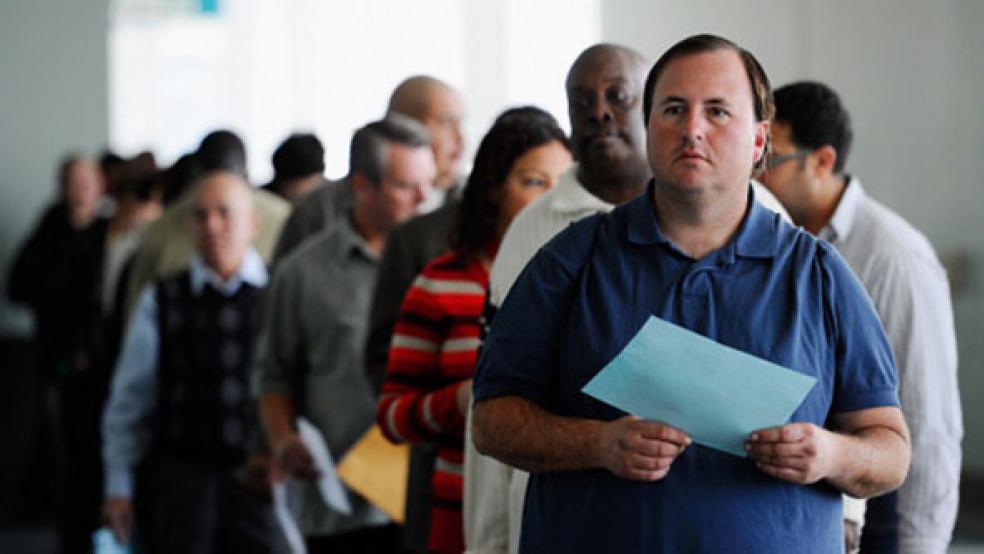The pace of economy recovery slowed significantly in May as employers added just 54,000 jobs, the slowest pace in eight months and far below the 150,000 gain analysts expected.
With government cutting back on employment and private sector job growth slowing, many economists now fear the economic recovery has stalled and could be heading for a double-dip recession. Government fiscal and monetary programs are set to expire between now and the end of the year, and traditional engines of economic growth like construction and housing are still in free fall.
Government layoffs of 28,000 workers last month are only a harbinger of what’s to come as Washington politicians focus on debt reduction, analysts said, while the wallet-draining effects of sky-high gasoline prices and lingering supply disruptions from the Japanese earthquake show no sign of abating.
“More worrisome is what happens next,” said Ryan Sweet, economist with Moody’s Analytics. “May's job data are only the latest in a series of disappointments that could rattle business confidence and potentially extend the recovery’s lull into the second half of the year.”
The unemployment rate edged up slightly to 9.1 percent, from 9 percent in April, the highest rate since December and the second consecutive increase, according to the Bureau of Labor Statistics. There are now 13.9 million people without jobs. Experts say the economy needs to add at least 200,000 to 250,000 jobs each month to keep up with population growth and prevent the unemployment rate from rising.
Stocks slid sharply immediately after the tepid report before recovering slightly as traders accommodated themselves to the glum reality that the U.S. remains mired in a slow-growth economy, which is the historical pattern after deep financial crises like the U.S. experienced in 2008 and 2009.
Job losses last month were widespread, led by the government sector. Cities and counties have lost 446,000 jobs since an employment peak in September 2008. With federal assistance to the states running out, that trend is likely to continue well into next year.
The manufacturing industry, which had been a star in the economic recovery, shed 5,000 jobs last month, after an average gain of 27,000 through the previous three months. The leisure and hospitality sector, which includes restaurants and hotels, cut 6,000 jobs, while retailers cut 8,500 positions, after adding 64,000 in April.
“Some of the declines last month may be employers' reactions to the spike in fuel prices,” said Marisa Di Natale, economist with Moody’s Analytics. The largest declines in nondurable manufacturing were in very energy-intensive industries such as food, printing and paper production.
May’s mediocre job growth comes after total nonfarm payroll employment had increased an average of 220,000 jobs in the prior three months. Private-sector employment in total added 83,000, a third of the previous three month average. The Labor Department said severe weather last month, including tornadoes and flooding, did not affect data collection.
“The inadequacy of job gains is a structural problem rather than a cyclical problem,” said Patrick O’Keefe, former Deputy Assistant Secretary in the U.S. Department of Labor. “The economy is able to grow and produce services with lower levels of labor force utilization. We have a structural misalignment—the skills and the location and willingness of workers to fill the jobs that are out there—are reasons why we are not making headway.”
The disappointing job gains will undoubtedly lead to calls for the Federal Reserve to continue with its quantitative easing beyond the scheduled conclusion of QE2 at the end of this month, said Paul Dales, economist from Capital Economics. Dales said he wouldn’t rule out a third round of quantitative easing either later this year or early 2012.
In an effort to boost the economy, the Federal Reserve has been buying $600 billion worth of Treasurys from investors who can then put the money in stocks and other investments.
“In terms of the labor market if we look at where we are today there has been some marginal increase in the number of jobs but it would suggest that the unemployment—which prompted the fed to act--QE2 has been a non event,” said O’Keefe, who has been an outspoken critics of the Fed’s actions.
The mediocre employment gains in May occurred in the construction industry which added 2,000 jobs. Mining added 7,000 jobs in May. Employment in mining has risen by 115,000 since a recent low point in October 2009. Health care continued to expand with 17,000 jobs. Employers have added an average of 24,000 jobs each month for the last year.
Despite the speculation that the big 50,000-person hiring spree by fast food giant McDonald’s would boost employment, food service payrolls only increased by 14,000.
The modest gains could add pressure on lawmakers to find a deficit reduction agreement quickly in order to raise the $14.3 trillion debt ceiling. The Treasury has said Congress needs to raise the government’s borrowing authority by August 2 or risk a default on debt for the first time in U.S. history. Republicans insist trillions of dollars in spending cuts must accompany a debt ceiling increase.
“Now is not the time for additional spending cuts,” said Robert Shapiro, former undersecretary of Commerce during the Clinton Administration. “It makes no sense at all.”
Also troubling in the report were the downward revisions of employment numbers for the previous two months. BLS said the employment report for March was revised from 221,000 to 194,000 and April was revised from 244,000 to 232,000 jobs.
The number of long-term unemployed (those jobless for 27 weeks and over) increased by 361,000 to 6.2 million while their share of unemployment increased to 45.1 percent, BLS said. “The harsh reality is that many former workers, especially in construction and low-skilled manufacturing, simply do not have the skills to compete for jobs in the 21st Century,” said Jon Silvia, economist with Wells Fargo. The high level of unemployment and duration suggests weak consumer spending going forward, Silvia added.
Related Links:
Hiring in U.S. Slowed in May with 54,000 Jobs (New York Times)
End of Stimulus Could Pull Economy Down Further (Fiscal Times)



